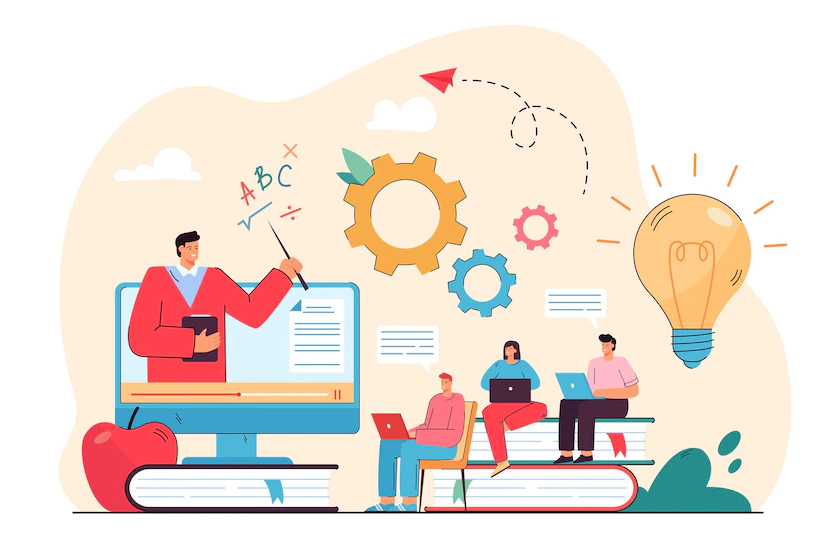Let's Discuss
Enquire NowThink about a rose garden. All roses in the garden receive the same amount of sunlight and water, yet some bloom well while others struggle to keep up. Every plant blooms differently depending on its type and the region where it’s planted. Much like them, the students in a classroom are also distinctive and unique. The traditional educational pattern involves a teacher delivering the same material to every student, at the same time, with limited consideration for individual needs.
According to research, learning is a highly dynamic process, which means that a student’s learning style might change from one day to another based on their mental and physical well-being. Elements such as prior knowledge, aptitude, and motivation also play an important role. Although it is well known that not all kids respond equally to traditional teaching methods, it is still in practice. Well, what can educators do to solve this dilemma?
Adaptive learning is one favorable solution.

What is Adaptive Learning?
Adaptive learning or Adaptive teaching is a data-driven, educational approach using computer algorithms and artificial intelligence to orchestrate a productive interaction between the teacher and the students. This method uses instructional resources that are tailored to the needs, learning preferences, and potential learning difficulties of each learner. It also incorporates elements drawn from several academic disciplines, including computer science, psychometrics, psychology, and brain science.
Adaptive Learning Algorithm:
Adaptive learning systems have been broken down into individual components or models:
- Expert model: This contains data about the subject matter being taught, such as answers to the questions, tutorials, expert methodologies, etc.
- Student model: This model tracks and learns about the student’s performance and skill level through adaptive testing methodologies, for instance, those employed in CAT.
- Instructional model: This model seeks the help of multimedia tools with expert teacher advice for presentation models.
The two major techniques used to create these models are content-based filtering and collaborative filtering.
Content-based Filtering: A content-based filtering algorithm works in similar ways to how Netflix promotes new series or movies based on user data. It is straightforward and even works with limited information about user activities.
Collaborative Filtering: This algorithm links multiple students in the same online platform based on elements such as the course they take, their knowledge level, learning style, etc.
Adaptive learning platforms would be equipped with all information needed for a particular course, including exercises, quizzes, animations, and other similar materials. After a student completes a task, the program will recommend appropriate levels based on their assessment. While some students breeze through the lessons, others might need to go over previous content again and again. The platform learns more about the needs of the students as they interact with it and then provides them with content that supports their learning objectives.
Adaptive learning, when used together with predictive analytics, has a significant potential to enhance student learning and produce fruitful learning outcomes. AI-based learning systems may gather and process enormous volumes of data from students’ learning activities, including the time spent on each activity, reaction latency, and test scores.
This technique allows teachers to create personalized learning plans that address different needs. The learning preferences of each student can be determined through a quick assessment. When teachers have this knowledge, they can use educational management software to apply a number of alternatives for the various learning styles in each class. Students may have a range of options, from traditional instructor-led courses to videos, quizzes, activities, learning sessions, etc.
Other use cases
The concepts of Adaptive Learning can be extended to game design. A 2014 study by educational researcher Edward D. Lavieri Jr. proposed and validated the Adaptive Learning GAme dEsign or ALGAE model, a robust adaptive learning model built on ideas of game design, instructional techniques, and adaptive models.
Some popular Adaptive Learning tools:
- Adobe Captivate
- Qualtrics
- Camtasia Relay
- Articulate storyline
Adaptive learning can become a vital method for enhancing education. This technique is especially beneficial for students dealing with conditions such as dyslexia, ADHD, and other learning difficulties. As with each rose in the garden, every child is unique and can bloom in beautiful ways when given the right kind of attention.
Have a project in mind related to EduTech? We can be your best partner! Connect with us here to unlock your dreams.
Disclaimer: The opinions expressed in this article are those of the author(s) and do not necessarily reflect the positions of Dexlock.



